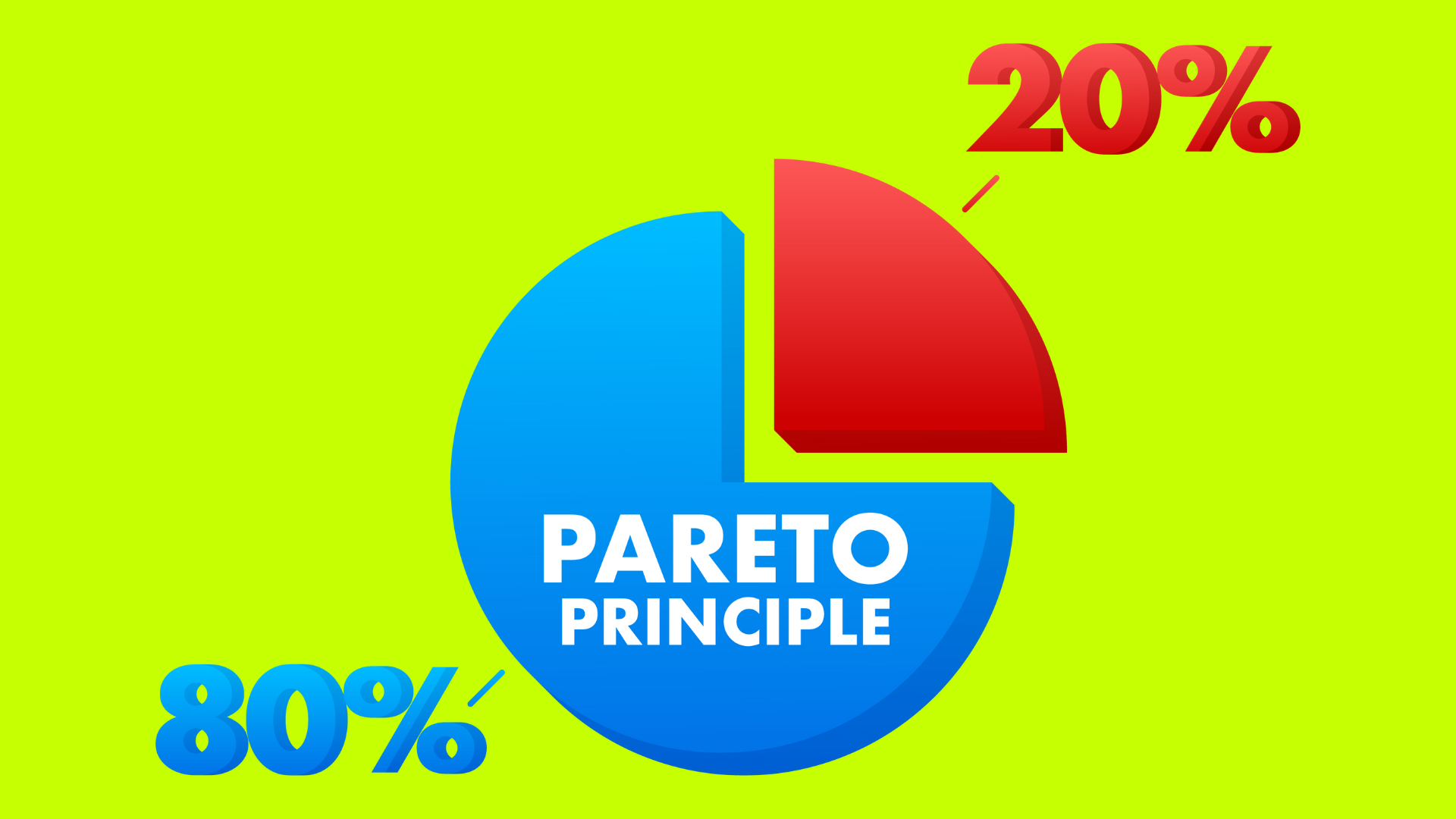Ever feel like you’re working tirelessly but not getting the results you want? Or perhaps you notice that only a few things you do make a big impact. If so, you’re not alone—and you’re not imagining things. The Pareto Principle, often referred to as the 80/20 rule, could be the answer you’re looking for. This simple yet powerful concept states that roughly 80% of outcomes come from just 20% of efforts. Imagine what you could achieve if you focused on that crucial 20%! In this blog post, we’ll dive deep into the Pareto Principle, explore its origins, and show you how to apply it in various aspects of your life, from business and productivity to personal development and beyond.
Table of Contents
What is the Pareto Principle?
The Pareto Principle, named after Italian economist Vilfredo Pareto, is a rule of thumb that suggests that 80% of the results come from 20% of the causes. Originally observed by Pareto when he noted that 80% of Italy’s wealth was owned by 20% of the population, this principle has since been recognized as a universal pattern in numerous areas. It’s not just about wealth or economics; it applies to almost every aspect of life, from business to personal habits, and even nature.
The key takeaway from the Pareto Principle is to identify and focus on the few things that make the biggest difference, rather than spreading your efforts thinly across many areas that yield little reward.
How the Pareto Principle Works
At its core, the Pareto Principle is about efficiency and effectiveness. It’s not always exactly 80/20; sometimes it’s 90/10 or 70/30, but the general idea remains the same: a small portion of efforts often accounts for a large portion of results. This imbalance can be found in:
- Business and Sales: 80% of a company’s revenue often comes from 20% of its clients.
- Productivity: 80% of your most productive work might come from 20% of your time.
- Customer Complaints: 80% of complaints often stem from 20% of customers.
- Time Management: 80% of tasks can be completed by focusing on the critical 20%.
Understanding and applying this principle allows you to leverage your time, resources, and energy more effectively.
Applying the Pareto Principle in Business
1. Focus on Key Clients and Products
One of the most impactful ways to use the Pareto Principle in business is to identify the top 20% of clients or products that generate the most revenue. Instead of spreading efforts equally across all clients, businesses can prioritize these high-value customers to enhance relationships, improve satisfaction, and boost sales. For instance, tailoring special offers, providing superior service, or investing more in these key products can significantly increase profitability.
2. Streamline Operations and Reduce Costs
By identifying the 20% of processes or resources that contribute most to operational efficiency, businesses can streamline their operations. This might involve cutting down on redundant tasks, focusing on core competencies, or investing in automation where it matters most. This targeted approach not only reduces costs but also improves overall productivity.
3. Improve Customer Satisfaction
In customer service, understanding that a small number of complaints often come from a specific source can help businesses address the root causes of dissatisfaction. By fixing the 20% of issues that lead to the majority of complaints, companies can improve customer experience significantly.

Using the Pareto Principle for Personal Productivity
1. Prioritize Your Tasks
Applying the Pareto Principle to your daily to-do list can transform how you work. Start by identifying the top 20% of tasks that will bring about 80% of your results. This may involve reviewing your goals, assessing deadlines, or understanding which tasks are aligned with your most important objectives. By focusing on these key tasks first, you can make significant progress without burning out on less impactful activities.
2. Time Management and Scheduling
It’s easy to get caught up in busy work that feels productive but yields little result. To counter this, allocate the majority of your time to the most important tasks—the 20% that matter. This might mean blocking off dedicated time slots for deep work, setting aside distractions, or using tools like time-blocking to ensure that your critical tasks receive the focus they deserve.
3. Cut Out the Non-Essentials
Not everything on your list is a priority. By identifying and eliminating the 80% of tasks that contribute little to your overall goals, you free up more time and energy for what truly matters. This can mean delegating, automating, or simply dropping tasks that do not add significant value to your work or personal life.

The Pareto Principle in Personal Development
1. Focus on High-Impact Habits
In personal development, the Pareto Principle can guide you to focus on the habits that have the greatest impact on your growth. For instance, instead of trying to overhaul your entire lifestyle at once, identify the few habits that can drive the most change. This might be regular exercise, mindfulness, or reading for personal growth. By focusing on these high-impact areas, you can achieve substantial improvements without overwhelming yourself.
2. Goal Setting and Achievement
When setting goals, it’s easy to become bogged down by too many objectives, losing sight of what’s most important. By applying the Pareto Principle, you can narrow your focus to the 20% of goals that will bring about the most significant changes in your life. This selective approach allows you to channel your efforts more effectively, increasing the likelihood of achieving your goals.
3. Learning and Skill Development
In today’s information-rich world, there’s no shortage of skills and knowledge to acquire. However, not all skills will have the same impact on your personal or professional life. Use the Pareto Principle to prioritize learning the 20% of skills that will deliver 80% of the results you’re looking for. For example, if you’re aiming to advance in your career, focus on mastering the critical skills that are most valued in your field.

Applying the Pareto Principle to Health and Wellness
1. Fitness and Exercise
In fitness, you don’t need to spend hours at the gym to see results. By identifying the exercises that yield the best outcomes, such as compound movements or high-intensity interval training (HIIT), you can get 80% of the benefits from just 20% of the workout time. This approach is not only efficient but also sustainable, helping you maintain consistency in your fitness journey.
2. Nutrition and Diet
The Pareto Principle can also be a game-changer in diet and nutrition. Focus on the 20% of foods that provide the bulk of your nutritional needs—like whole foods, vegetables, lean proteins, and healthy fats. By prioritizing these nutrient-dense options, you can improve your diet without the need for complex meal plans or restrictive diets.
3. Mental Health and Stress Management
When it comes to mental health, the Pareto Principle suggests focusing on the few activities that significantly enhance your well-being. This might include mindfulness practices, regular exercise, or maintaining strong social connections. By prioritizing these key areas, you can manage stress more effectively and improve your overall mental health.

Challenges and Limitations of the Pareto Principle
While the Pareto Principle is incredibly useful, it’s not without its challenges and limitations. One common misconception is that it can be applied rigidly to all situations, but the 80/20 split is more of a guideline than a strict rule. Sometimes, the ratio may vary, and other times, external factors may influence the outcomes beyond the identified 20%.
Additionally, over-reliance on the Pareto Principle can lead to neglect of the remaining 80% that, while less impactful, are still necessary. For example, in customer service, focusing only on the top clients might cause you to overlook smaller clients who could become more significant over time. It’s essential to strike a balance and not dismiss the larger picture.
Tips for Successfully Applying the Pareto Principle
- Start with Analysis: Begin by analyzing your current efforts to identify the 20% that are most effective. Use data and metrics to support your findings wherever possible.
- Set Clear Priorities: Once you’ve identified the key areas, set clear priorities and allocate resources accordingly. This might mean shifting time, budget, or effort towards high-impact activities.
- Regularly Re-Evaluate: The Pareto Principle isn’t a one-time fix. Regularly reassess your efforts and results to ensure that your focus remains on the most critical areas.
- Be Flexible: While focusing on the vital few is essential, remain flexible to adjust as needed. Sometimes new opportunities or challenges will arise that require a shift in focus.
- Educate Your Team: If applying the Pareto Principle in a business or team setting, ensure that everyone understands its value and how to apply it. This collective effort can maximize the benefits across the board.
Conclusion
The Pareto Principle is a powerful tool that can transform the way you approach your work, personal development, and even health. By understanding and focusing on the critical 20% that drives the majority of your results, you can achieve more with less effort and stress. Whether you’re looking to improve productivity, enhance your business, or make meaningful changes in your personal life, the 80/20 rule provides a clear path to efficiency and effectiveness.
Remember, the goal isn’t to ignore the 80% completely but to recognize where your efforts are best spent. As you start applying the Pareto Principle in your life, you’ll likely find yourself more focused, more productive, and better equipped to achieve your goals. So, take the first step today—identify your 20%, and let the Pareto Principle work its magic.
Discover more from Positive Treasure
Subscribe to get the latest posts sent to your email.




